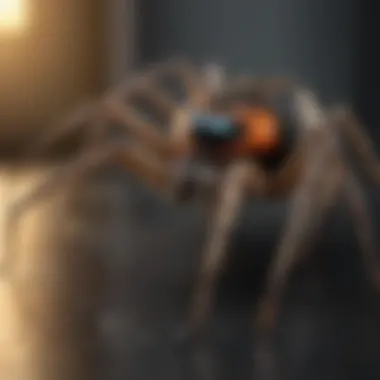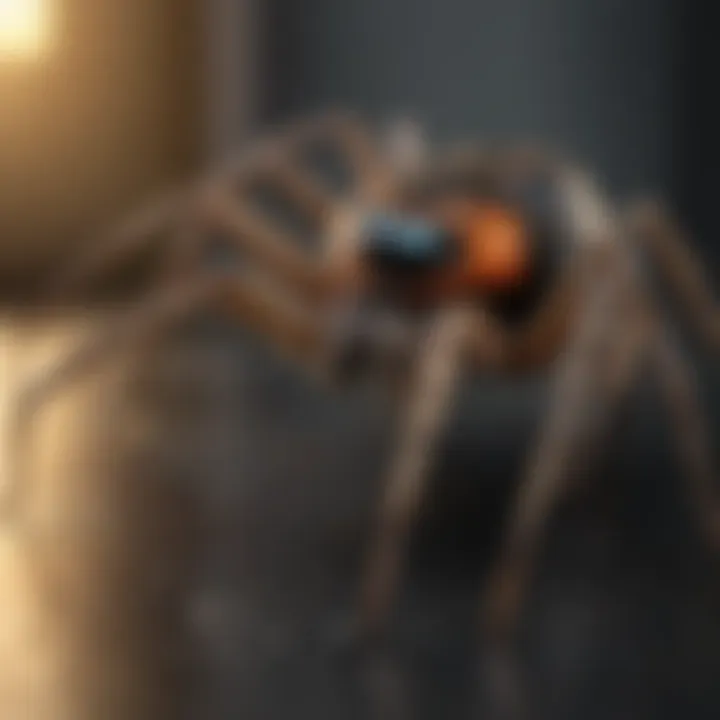Expert Guide to Selecting the Best Spider Plug-In Repellent for Your Space


Preventive Pest Control Strategies
When combating pests, it's crucial to start with preventive measures to keep your space pest-free. This begins with protecting your house exteriors. Seal any cracks in walls and foundations to prevent access for pests. Regularly clear debris from your surroundings that may provide hiding spots for pests. Implement strategies to restrict pests from entering your home, such as using door sweeps and screens.
In addition to safeguarding your home's exterior, yard maintenance plays a vital role in pest control. Maintain your yard through essential routines like mowing the lawn and trimming bushes. Adopt pest-free yard methods, such as eliminating standing water that attracts pests like mosquitoes.
Indoor cleanliness is another key aspect of pest prevention. Follow expert cleaning techniques to keep your living spaces free of crumbs and debris that may attract pests. Additionally, create a pest-resistant indoor environment by sealing gaps around pipes and maintaining proper ventilation.
Effective garbage disposal is essential in keeping pests at bay. Dispose of waste efficiently to deter pests like rodents and insects from scavenging in your trash. Proper garbage disposal not only reduces odors that attract pests but also contributes to overall hygiene in your home.
Lastly, explore innovative pest prevention strategies to further safeguard your living space. This can include installing pest-repellent lighting around your property or utilizing ultrasonic pest repellents that emit frequencies to deter pests.
Understanding Spider Behavior
Understanding spider behavior is crucial when selecting the best spider plug-in repellent for your needs. By delving into the key characteristics and common infestation areas of spiders, you gain valuable insight into their habits and preferences, informing your choice of repellent. Whether spiders tend to gravitate towards indoor spaces or lurk in outdoor environments, a deep understanding of their behavior enables you to strategically place repellent devices for maximum effectiveness. This section explores the intricate details of spider behavior, shedding light on their physical attributes and behavioral traits.
Key Characteristics of Spiders
Physical Attributes
When it comes to physical attributes, spiders possess unique features that set them apart from other pests. Their eight legs, segmented bodies, and multiple eyes make them easily recognizable. These physical traits allow spiders to navigate diverse terrains with agility, facilitating their ability to establish webs in hard-to-reach areas within your living space. Although their appearance may trigger fear in many individuals, understanding these physical characteristics is essential for implementing targeted repellent strategies.
Behavioral Traits
Spiders exhibit fascinating behavioral traits that influence their interactions with humans and their surroundings. From their predatory nature to their silk-spinning abilities, spiders play a pivotal role in natural ecosystems. By grasping their behavioral tendencies such as nocturnal habits and web-building patterns, you can devise proactive measures to deter them effectively. By acknowledging the advantages and disadvantages of these behavioral traits, you can select a spider plug-in repellent that aligns with the behavioral nuances of these arachnids.
Common Spider Infestation Areas
Indoor Spaces
Indoor spaces serve as hotspots for spider infestations due to the presence of cozy hiding spots and easy access to prey. Common indoor areas where spiders thrive include dark corners, storage areas, and closets. Spiders favor these locations for nesting and hunting, necessitating targeted repellent application to mitigate infestation risks. Recognizing the unique feature of indoor spaces as preferred spider habitats is crucial for effectively combating spider populations indoors.
Outdoor Spaces
Spider infestations in outdoor spaces pose distinct challenges compared to indoor environments. Gardens, sheds, and outdoor structures provide ample hiding spots for spiders to build webs and feed on insects. Understanding the key characteristic of outdoor spaces as potential spider breeding grounds empowers you to implement comprehensive repellent strategies. By evaluating the advantages and disadvantages of outdoor spider infestations, you can choose a plug-in repellent suited for outdoor usage to maintain a spider-free exterior environment.
Factors to Consider When Choosing a Spider Plug-In Repellent


When embarking on the journey to select the ideal spider plug-in repellent for your space, various factors come into play, each crucial to the effectiveness and efficiency of the product. Understanding these considerations is paramount when striving for a spider-free environment. Firstly, the efficacy of the repellent against spiders is a primary concern. Additionally, ensuring the safety of humans and pets is essential, as well as evaluating the ease of use and installation of the repellent.
Effectiveness Against Spiders
Types of Repellents
In the realm of spider plug-in repellents, the diversity of available types can be overwhelming. From ultrasonic technology to natural solutions, each type boasts distinct characteristics that set it apart in the market. The effectiveness of these repellents primarily hinges on their mode of action and interaction with spider behavior patterns. Understanding the specific traits of each type is crucial in making an informed decision about the most suitable option for your space.
Ultrasonic Repellents emit high-frequency sound waves that are disruptive to spider auditory senses, deterring them from inhabiting the area. This technology is widely favored for its non-intrusive nature and eco-friendly attributes. However, some users may find the sound unsettling, which could be a drawback in certain settings.
Active Ingredients
The active ingredients present in spider plug-in repellents play a pivotal role in their overall effectiveness. These substances, whether botanical extracts or chemical compounds, determine the repellent's ability to repel spiders successfully. Understanding the properties and potential side effects of these ingredients is crucial in selecting a repellent that aligns with your safety and efficacy preferences.
Botanical Extracts are gaining popularity for their natural and eco-friendly composition. Ingredients like peppermint oil, citronella, or lavender are known for their spider-repelling properties without posing harm to humans or pets. However, their longevity and potency may vary compared to chemical alternatives.
Safety for Humans and Pets
Non-Toxic Formulas
When considering a spider plug-in repellent, opting for non-toxic formulas ensures a safe environment for both inhabitants and pets. These formulations utilize natural ingredients that are harmless to humans and animals while effectively repelling spiders. The assurance of a chemical-free solution provides peace of mind for those concerned about potential health risks associated with traditional repellents.
Essential Oils are often key components in non-toxic formulas due to their organic nature and pleasant fragrance. Oils such as tea tree, eucalyptus, or lemon offer a botanical alternative to chemical repellents, promoting a healthy living space free from harmful fumes and residues.
Pet-Friendly Options
For households with furry companions, integrating pet-friendly options into spider repellents is essential. These solutions cater to the well-being of pets by excluding harmful substances that could pose a threat to their health. Prioritizing repellents specifically formulated to be safe for pets ensures a harmonious living environment for all residents, human and animal alike.
Low-Impact Formulas are designed to be gentle on pets' senses, avoiding strong odors or toxic compounds that might agitate or harm them. Incorporating pet-friendly options guarantees a balanced approach to pest control that considers the welfare of all household members.
Ease of Use and Installation
Plug-In Design
The design of the plug-in repellent holds significance in its practicality and effectiveness. A well-crafted design enhances the distribution of repelling agents throughout the designated area, maximizing coverage and efficacy. Evaluating the design features ensures a seamless integration of the repellent into your living space while optimizing its spider-deterring capabilities.
Dual-Action Devices that combine ultrasonic technology with light or heat sources offer a comprehensive approach to spider control. These multifunctional designs not only repel spiders but also illuminate dark corners or provide supplemental warmth, enhancing the utility of the plug-in device.
Coverage Area


Determining the coverage area of a plug-in repellent is crucial in effectively protecting your space from spider infestations. The extent to which the repellent can reach and deter spiders influences its overall performance. Understanding the range and limitations of the device empowers users to strategically place it for maximum impact.
Wide-Angle Coverage Repellents utilize advanced dispersal mechanisms to reach expansive areas within a room or outdoor space. By encompassing a broader scope, these repellents target multiple potential entry points for spiders, creating a comprehensive barrier against arachnid intrusions.
Top Recommendations for Spider Plug-In Repellents
In this section, we delve into the crucial topic of selecting the top recommendations for spider plug-in repellents, a decision that can significantly impact the effectiveness of your spider control strategy. When considering the best options, factors such as product performance, safety for humans and pets, ease of use, and longevity play a pivotal role. By carefully evaluating these aspects, you can ensure a spider-free environment in your home or workplace.
Product A: Natural Repellent Plugin
Key Features
When exploring the key features of a natural repellent plugin, it is essential to highlight its organic composition, free from harmful chemicals. This eco-friendly characteristic not only ensures the safety of your family and pets but also reduces the environmental impact. Additionally, the pleasant fragrance of natural ingredients adds a soothing ambiance to your living space, making it a popular choice for those seeking a non-toxic and sustainable spider repellent solution.
Customer Reviews
Customer reviews provide valuable insights into the practical efficacy of a natural repellent plugin. Positive reviews often commend its ability to repel spiders effectively without posing any health risks. However, some users may find the scent overpowering or the coverage area insufficient. Understanding these reviews can guide your decision-making process, helping you determine if this natural repellent aligns with your preferences and requirements.
Product B: Ultrasonic Spider Repellent
Technology Overview
The ultrasonic spider repellent operates based on sound waves that are imperceptible to humans but disturb spiders, compelling them to vacate the treated area. This innovative technology offers a silent and non-intrusive solution to spider infestations, making it a favorable choice for those who prefer a hands-free approach to pest control.
Effectiveness Ratings
Effectiveness ratings measure the success of ultrasonic spider repellents in deterring arachnids. While some users report a significant reduction in spider activity after installing the device, others may experience limited results depending on factors like room size or spider species. Understanding these effectiveness ratings allows you to set realistic expectations and optimize the repellent's placement for maximum impact.
Product C: Long-Lasting Plugin Repellent
Duration of Protection
The duration of protection provided by a long-lasting plugin repellent is a key feature to consider when selecting a spider repellent. These devices typically offer extended coverage, ensuring continuous spider deterrence for an extended period. However, the effectiveness may diminish over time, requiring regular maintenance and potential refill replacements to uphold peak performance.
Value for Money
Assessing the value for money offered by a long-lasting plugin repellent involves evaluating its cost-effectiveness in relation to its durability and efficacy. While a higher initial investment may indicate superior quality and longer protection, affordability remains a crucial factor for many buyers. Striking a balance between cost and performance can help you choose a plugin repellent that delivers optimal value and spider control benefits for your space.
Maintenance Tips for Optimal Repellent Performance


In the realm of spider plug-in repellents, ensuring optimal performance is key to maintaining a spider-free environment. Regular maintenance plays a crucial role in the efficacy of these devices. By following a few simple steps, you can significantly enhance the performance and longevity of your repellent, guaranteeing a pest-free zone within your living spaces. Maintaining your repellent device involves a combination of cleaning procedures and timely refill replacements. Regular upkeep not only ensures the continued efficiency of the repellent but also contributes to a healthier and cleaner living environment for you and your family.
Regular Cleaning Procedures
Device Maintenance:
Device maintenance is a vital aspect of upkeeping your spider plug-in repellent. Regularly cleaning and inspecting the device can prevent dust buildup and potential malfunctions. By wiping the device with a damp cloth and ensuring no blockages are present, you maintain its functionality and effectiveness. Additionally, checking for any loose connections or damaged parts can extend the lifespan of the repellent, making it a cost-effective choice for your pest control needs.
Area Cleanliness:
Maintaining general cleanliness in the vicinity of the repellent is equally important. A clean environment reduces the attractiveness of the area to spiders, complementing the repellent's efforts. Regularly vacuuming or sweeping the surroundings helps eliminate spider webs, eggs, and other debris that could compromise the repellent’s performance. Ensuring a clutter-free and tidy space not only deters spiders but also promotes a hygienic living space for you and your loved ones.
Replacing Repellent Refills
Indicators for Refill Change:
Recognizing the signs that indicate the need for refill replacement is crucial for uninterrupted spider control. Different repellents may have specific indicators, such as a diminishing scent or effectiveness. Understanding these signals allows you to proactively replace the refill, ensuring continuous protection against spiders. By being attentive to these cues, you can optimize the repellent's performance and maintain a spider-free environment efficiently.
Refill Replacement Frequency:
Determining the ideal frequency for replacing repellent refills depends on various factors, including the repellent type and usage. Regularly replacing refills according to the manufacturer's recommendations is essential for sustained spider control. Maintaining a consistent refill replacement schedule guarantees continued effectiveness and provides long-term cost savings by preventing infestations. By adhering to a refill replacement routine, you can enjoy a spider-free space without disruptions in protection.
Additional Precautionary Measures Against Spiders
In the realm of pest control, especially when combating arachnids like spiders, it is essential to go the extra mile by implementing additional precautionary measures. These measures serve as a crucial line of defense, complementing the use of spider plug-in repellents to ensure a comprehensive approach to spider prevention. By incorporating these precautions, homeowners can create a hostile environment for spiders, dissuading them from invading living spaces and breeding.
Sealing Entry Points
Caulking Procedures:
Caulking procedures play a pivotal role in sealing off potential entry points that spiders might exploit to gain access to homes. The meticulous application of caulk along gaps, cracks, and crevices in walls, floors, and foundations acts as a formidable barrier against spider intrusion. The impermeability of caulk restricts spiders' mobility and reduces the likelihood of them finding shelter within the confines of households. This method is highly regarded for its efficacy in preventing spider infestations, making it a sought-after choice for those seeking long-term spider control solutions.
Screen Repairs:
Another critical aspect of sealing entry points involves the maintenance and repair of screens on windows and doors. Screens serve as a primary defense mechanism against spider entry, acting as a physical barrier that blocks their path into homes. By addressing any tears, holes, or integrity issues in screens, homeowners fortify their defenses against spider infiltration. The reliability of screens in keeping spiders at bay makes screen repairs a popular and effective strategy in the ongoing battle against arachnid intruders.
Outdoor Area Maintenance
Landscape Modifications:
Landscape modifications encompass strategic changes to outdoor surroundings aimed at discouraging spider habitation. By altering the layout, vegetation, and moisture levels in the vicinity of the property, homeowners can create an environment that is less hospitable to spiders. These modifications may include trimming overgrown vegetation, reducing mulch and leaf litter, and optimizing drainage to limit areas where spiders can thrive. Through mindful landscaping adjustments, homeowners can significantly decrease the attractiveness of their outdoor spaces to spiders.
Debris Removal:
Effective outdoor area maintenance involves regular debris removal to eliminate potential spider harborage sites. Clearing away piles of wood, rocks, leaves, and other clutter deprives spiders of favorable habitats, forcing them to seek shelter elsewhere. By prioritizing cleanliness and orderliness in outdoor areas, homeowners can disrupt the conditions that attract spiders, contributing to a proactive approach in spider control. The simplicity and impact of debris removal make it a practical and beneficial measure in mitigating spider infestations.



